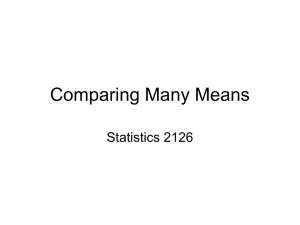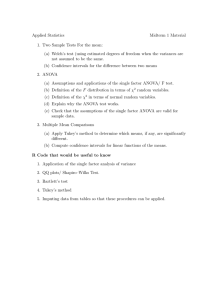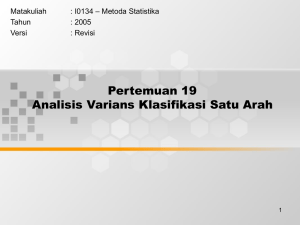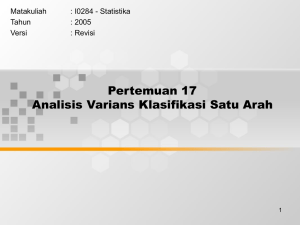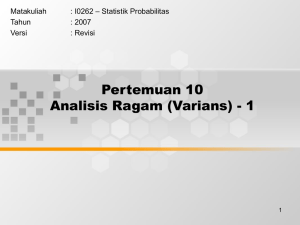Variance component estimation 1/16
advertisement
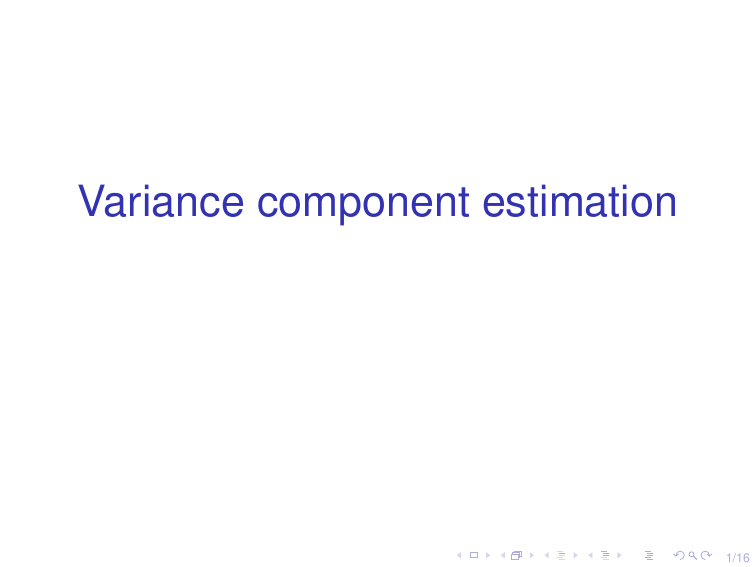
Variance component estimation
1/16
Linear mixed models
In general, a linear mixed model may be represented as
Y = X β + Zu + ε,
where
I
Y is an n × 1 vector of response;
I
X is an n × p design matrix;
I
β is a p × 1 vector of “fixed” unknown parameter values;
I
Z is an n × q model matrix of known constants;
I
u is a q × 1 random vector;
I
ε is an n × 1 random error.
2/16
Linear mixed models
We typically assume that
E(ε) = 0, Var(ε) = R, E(u) = 0, Var(u) = G.
As a result,
Var(Y ) = ZGZ T + R.
3/16
Generalized LSE
I
For any estimable function C T β, the unique BLUE is
T β = C T (X T Σ−1 X )− X T Σ−1 Y .
Cd
I
Note that Σ = ZGZ T + R and G, R are typically unknown.
G and R are functions of some unknown parameters. We
need to estimate G and R by replacing the unknown
parameters in G and R by their estimators.
4/16
Variance component estimation
Three basic methods:
I
ANOVA methods (method of moments)
I
Maximum likelihood (ML) method
I
Restricted ML method (REML)
5/16
ANOVA methods
ANOVA methods:
I
Step 1: Compute an ANOVA table
I
Step 2: Find the expectation of the mean squares
I
Step 3: Equate the mean squares to their expectations and
solving the resulting equations
6/16
Example: random blocks (penicillin production)
I
Comparison of four processes for producing penicillin.
I
Four processes A, B, C and D, levels of a “fixed” effect
treatment.
I
Random sample of five batches of raw material, corn steep
liquor.
I
Split each batch into four parts. Run each process on one
part, and randomize the order in which the processes are
run with each batch.
7/16
Example continued
Let us consider the following random block effects model:
Yij = µ + αi + γj + εij , i = 1, · · · , a; j = 1, · · · , b,
iid
where γj is the random block effect (batch effect), γj ∼ N(0, σγ2 ),
iid
εij ∼ N(0, σ 2 ) and γj ’s are independent of εij ’s.
8/16
Variance covariance structure
If a = 4, the variance covariance of Yj = (Y1j , Y2j , Y3j , Y4j )T is
Var(Yj ) =
σγ2 + σ 2
σγ2
σγ2
σγ2
σγ2
σγ2 + σ 2
σγ2
σγ2
σγ2
σγ2
σγ2 + σ 2
σγ2
σγ2
σγ2
σγ2
σγ2 + σ 2
.
The above variance covariance structure is a function of σ 2 and
σγ2 . We need to estimate the unknown variance components σ 2
and σγ2 .
9/16
Random block effects model
For the above random block effects model, we can write the
model as
Y11
Y
21
..
.
Yab
µ
1a
0
···
0
γ1
α1
..
.
+
0
..
.
1a
..
.
···
..
.
0
..
.
γ2
..
.
0
0
···
1a
ε
21
+
..
.
εab
1a
0
···
0
0
and
Z
=
..
.
Ia
0
1a
..
.
···
..
.
0
..
.
.
0
···
1a
=
1a
..
.
Ia
..
.
1a
Ia
αa
γb
ε11
.
Denote
1a
..
X = .
1a
Ia
..
.
10/16
ANOVA table
From what have learned in Chapter 1, the variance explained
by αi ’s is
SSA = R(αi0 s|µ) = Y T (PX − P1ab )Y ,
where 1ab = (1Ta , · · · , 1Ta )T , PX = X (X T X )− X T and
P1ab = 1ab (1Tab 1ab )− 1Tab .
Similarly, the variance explained by by γj ’s is
SSA = R(γj0 s|µ, αi0 s) = Y T (P(X ,Z ) − PX )Y .
and the sum of square of error is
SSE = Y T (I − P(X ,Z ) )Y .
11/16
ANOVA method
Step 1: The ANOVA table is
Source Sum of Squares
P
αi0 s
SSA = b ai=1 (Ȳi· − Ȳ·· )2
P
γj0 s
SSB = a aj=1 (Ȳ·j − Ȳ·· )2
P P
error SSE = ai=1 bj=1 (Yij − Ȳi· − Ȳ·j + Ȳ·· )2
DF
a−1
b−1
(a − 1)(b − 1)
12/16
ANOVA method
Step 2: we can show the following
E(MSE) = σ 2
E(MSB) = σ 2 + aσγ2
a
E(MSA) = σ 2 +
b X
(αi − ᾱ)2
a−1
i=1
where MSE = SSE/{(a − 1)(b − 1)}, MSA = SSA/(a − 1) and
MSB = SSB/(b − 1).
13/16
ANOVA method
Step 3: Equate the MS with their expectations
MSE = σ 2
MSB = σ 2 + aσγ2
a
MSA = σ 2 +
b X
(αi − ᾱ)2
a−1
i=1
Then we obtain the estimation of variance components as
following
σ̂ 2 = MSE
σ̂ 2 = (MSB − MSE)/a.
14/16
Example: Hierarchical (nested) random effects model
Analysis of sources of variation in a process used to monitor
the production of pigment paste. The following sampling
scheme is used
I
Sample b barrels of pigment paste
I
Take s samples from each barrel
I
Each sample is mixed and divided into r parts. Each part is
sent to the lab for determination of moisture content
There are a total of n = bsr observations.
15/16
Example continued
Measured response: moisture content of the pigment paste.
Problem: variation in moisture content is too large, with average
moisture content approximately 2.5% and the standard
deviation is about 0.6%.
Goal: to identify the sources of variation in order to improve the
pigment pate production.
16/16
